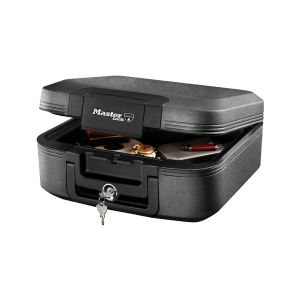What Should I Look For In A Fireproof Safe?
A fireproof safe does share some characteristics with a standard safe, in terms of what they look like and the security systems used to access them. But the main difference is that a fireproof safe is typically used to store items that are irreplaceable or highly sensitive. These refer to both domestic safes and commercial business safes. Typically a fireproof safe would be used to store three types of items:
- Documents – in a home these would be items that had emotional value rather than financial value, such as photographs or letters, while this could also include important documents such as passports, insurance policies or property deeds. For a business this could include commercially sensitive documents such as product specifications or contracts.
- Digital media – this would include USB sticks, CDs and DVDs and iPods. These can contain valuable data, and in the case of a commercial business, it has a duty to protect personal data.
- Magnetic media – this would include computer back-up tapes, discs and hard drives, plus older forms of data collection, such as microfiches and transparencies.
All these types of information and data require protection from fire, because they are unique and cannot easily be replaced, or contain very sensitive material, not because they are desirable in a financial sense. However, you can still store cash and other valuables in a fireproof safe, so there is still a need for a fireproof safe to be secure and robust, as well as being able to withstand fire.
Why do we need a fireproof safe?
Fire in the home or in the workplace can create smoke, flames, dust and gases, which are all harmful to the types of items we have discussed here. In addition to actually burning items, heat can corrupt digital media and cause magnetic interference which will spoil magnetic media at certain temperatures.
When fireproof safes are manufactured they are tested against various safety standards, to ensure they are able to withstand specific temperatures and therefore provide certain levels of protection. Popular test standards include EN 14450 S1, EN 14450 S2 and EN 1443-1. These standards can be attributed to a specific safe and will denote what it is advisable to store in each type of safe. This includes various amounts of cash, and therefore, how much cover you have for insurance purposes if you choose to store cash in a particular safe.
The typical properties of a fireproof safe

A fireproof safe can differ in size and appearance, but in the most part looks much the same as a normal safe. However, we do need to understand the key differences:
- Locking system – this will be the same as a standard safe, and can be a system which uses a physical key, a combination lock, an electronic lock with a keypad, or a lock that is accessed via a biometric feature, ie. facial recognition, fingerprint or retina scan.
- Robust – a fireproof safe is designed to be robust, so in addition to the locking system it will have strong and thick steel walls.
- Installation – you should always follow a manufacturers recommendations for installing a fireproof safe. Some models shouldn’t be secured using bolts (ie. to fix to a wall or floor) because it will compromise the fireproof materials in the safe walls, and hence will invalidate the fire rating of the safe. This could cause an issue from an insurance point of view.
- Size – a fireproof safe will look the same size as a standard safe from the outside, but the actual storage capacity internally may be much smaller than it looks. This is because most fireproof safes have a wall cavity which is filled with fireproofing materials. While you are usually storing smaller items in a fireproof safe, you may need to order a larger safe than you planned to for this reason.
- Fire rating – this is the key to how effective a fireproof safe is in protecting your documents or data storage materials. A fire rating is an indication of how long a safe should ordinarily protect your materials from the threat of fire. This is usually ranging from 30 minutes to four hours (240 minutes). So you would choose a fire rating depending on what you were planning to store, what the surrounding fire risks were and how easily you could access and retrieve the contents of the safe in the event of a fire. So the longer the safe protects its contents, the higher the fire rating.
- Fire protection – this is how effective the safe is in actually protecting the contents. Safes are designed to keep the internal chamber cool, but humidity will build up if a fire is ongoing, so you need to know how well a safe is going to perform in terms of protecting what is in there. Typically, paper documents will be unaffected by fire up to 177°C, while digital media is OK up to 120°C and magnetic media up to 52°C.
What to look for in a fireproof safe
So when you are looking to purchase a fireproof safe you should be looking for:
- How long you need to protect your materials
- How big the items are
- Do you need to store cash also?
- How and by whom will the safe be accessed?
- What kind of budget do you have?
These factors will determine the fire rating of the safe you need, how big it is, what kind of locking system is appropriate and where the safe will be stored and installed. If you need help in choosing the right fireproof safe, then contact our experts at MB Direct and we can talk to you about our range of fireproof safes and what would be best for you.